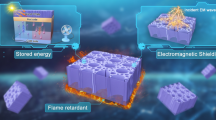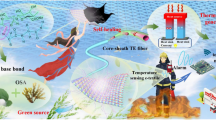Abstract
Completely sustainable triboelectric nanogenerators (TENGs) with bio-based raw materials, green synthesis, resource-saving processing, durable mechanical and electrical performance, facile recycling, and degradation properties are highly desired for green energy harvesting and wearable electronics, but their preparation remains a challenge. This study develops bio-based vitrimers combining green synthesis, excellent elasticity, biodegradability, and recyclability to address this challenge. A salt-assisted three-dimensional (3D) printing strategy is developed to fabricate mechanically robust TENGs with hierarchical porous structures. The triboelectric contact between the surfaces and external triboelectric materials as well as that of the internal hierarchical pore’s wall contributes to the excellent electrical output performance. The resultant TENGs could be easily recycled into different forms by light-assisted fabrication to extend their lifetime. The main part of discarded TENGs shows facile degradation under benign conditions without negative influence on the environment, while the high-value conductive fillers can be readily recycled. Overall, this work presents a new paradigm for completely sustainable TENGs, which will inspire the development of sustainable electronic devices.

摘要
具有生物来源、 “绿色”制备、 稳定的力学和电学性能、 可循环利用、 可降解的摩擦纳米发电机在绿色能源收集和可穿戴器件应用中意义重大, 但是其制备仍存在挑战. 据此, 本工作发展了具有优异的弹性、 生物降解性和可循环性的生物基类玻璃弹性体来应对上述挑战. 我们以弹性体和碳纳米管为原料通过盐粒辅助的3D打印技术制备了具有多级孔结构的摩擦纳米发电机. 该摩擦纳米发电机表现出优异的力学和电能输出性能, 并能够通过光致加工手段实现回收再利用; 而废弃的摩擦纳米发电机也能够通过弹性体的降解和碳纳米管的回收, 有效节约资源和减少污染. 本工作为完全可持续性摩擦纳米发电机提供了一个新的范例, 对可持续性电子器件的发展具有一定的启发意义.
Similar content being viewed by others
References
Chiong JA, Tran H, Lin Y, et al. Integrating emerging polymer chemistries for the advancement of recyclable, biodegradable, and biocompatible electronics. Adv Sci, 2021, 8: 2101233
Wang C, Yokota T, Someya T. Natural biopolymer-based biocompatible conductors for stretchable bioelectronics. Chem Rev, 2021, 121: 2109–2146
Liu K, Tran H, Feig VR, et al. Biodegradable and stretchable polymeric materials for transient electronic devices. MRS Bull, 2020, 45: 96–102
Guo H, Chen J, Wang L, et al. A highly efficient triboelectric negative air ion generator. Nat Sustain, 2021, 4: 147–153
He W, Fu X, Zhang D, et al. Recent progress of flexible/wearable self-charging power units based on triboelectric nanogenerators. Nano Energy, 2021, 84: 105880
Xie L, Yin L, Liu Y, et al. Interface engineering for efficient raindrop solar cell. ACS Nano, 2022, 16: 5292–5302
Liu J, Wen Z, Lei H, et al. A liquid-solid interface-based triboelectric tactile sensor with ultrahigh sensitivity of 21.48 kPa−1. Nano-Micro Lett, 2022, 14: 88
Chen X, Liu Y, Sun Y, et al. Electron trapping & blocking effect enabled by MXene/TiO2 intermediate layer for charge regulation of triboelectric nanogenerators. Nano Energy, 2022, 98: 107236
Chen C, Wen Z, Shi J, et al. Micro triboelectric ultrasonic device for acoustic energy transfer and signal communication. Nat Commun, 2020, 11: 4143
Zhang B, Tang Y, Dai R, et al. Breath-based human-machine interaction system using triboelectric nanogenerator. Nano Energy, 2019, 64: 103953
Shan L, Liu Y, Zhang X, et al. Bioinspired kinesthetic system for human-machine interaction. Nano Energy, 2021, 88: 106283
Wang L, Liu W, Yan Z, et al. Stretchable and shape-adaptable tribo-electric nanogenerator based on biocompatible liquid electrolyte for biomechanical energy harvesting and wearable human-machine interaction. Adv Funct Mater, 2021, 31: 2007221
Ye C, Yang S, Ren J, et al. Electroassisted core-spun triboelectric nanogenerator fabrics for intellisense and artificial intelligence perception. ACS Nano, 2022, 16: 4415–4425
Shi X, Zhang S, Gong S. A self-powered and arch-structured tribo-electric nanogenerator for portable electronics and human-machine communication. J Mater Chem A, 2020, 8: 8997–9005
Tang Q, Yeh MH, Liu G, et al. Whirligig-inspired triboelectric nano-generator with ultrahigh specific output as reliable portable instant power supply for personal health monitoring devices. Nano Energy, 2018, 47: 74–80
Xia X, Liu Q, Zhu Y, et al. Recent advances of triboelectric nanogenerator based applications in biomedical systems. EcoMat, 2020, 2: 12049
Ouyang H, Li Z, Gu M, et al. A bioresorbable dynamic pressure sensor for cardiovascular postoperative care. Adv Mater, 2021, 33: 2102302
Zhao C, Cui X, Wu Y, et al. Recent progress of nanogenerators acting as self-powered drug delivery devices. Adv Sustain Syst, 2021, 5: 2000268
Rahimi AR, García JM. Chemical recycling of waste plastics for new materials production. Nat Rev Chem, 2017, 1: 0046
Zhang X, Sheng N, Wang L, et al. Supramolecular nanofibrillar hydrogels as highly stretchable, elastic and sensitive ionic sensors. Mater Horiz, 2019, 6: 326–333
Patel T, Kim MP, Park J, et al. Self-healable reprocessable triboelectric nanogenerators fabricated with vitrimeric poly(hindered urea) networks. ACS Nano, 2020, 14: 11442–11451
Sun Q, Wang L, Yue X, et al. Fully sustainable and high-performance fish gelatin-based triboelectric nanogenerator for wearable movement sensing and human-machine interaction. Nano Energy, 2021, 89: 106329
Xia K, Wu D, Fu J, et al. Tunable output performance of triboelectric nanogenerator based on alginate metal complex for sustainable operation of intelligent keyboard sensing system. Nano Energy, 2020, 78: 105263
Pang Y, Xi F, Luo J, et al. An alginate film-based degradable triboelectric nanogenerator. RSC Adv, 2018, 8: 6719–6726
Chi Y, Xia K, Zhu Z, et al. Rice paper-based biodegradable triboelectric nanogenerator. Microelectron Eng, 2019, 216: 111059
Khandelwal G, Minocha T, Yadav SK, et al. All edible materials derived biocompatible and biodegradable triboelectric nanogenerator. Nano Energy, 2019, 65: 104016
Xia R, Zhang R, Jie Y, et al. Natural cotton-based triboelectric nano-generator as a self-powered system for efficient use of water and wind energy. Nano Energy, 2022, 92: 106685
Liang Q, Zhang Q, Yan X, et al. Recyclable and green triboelectric nanogenerator. Adv Mater, 2017, 29: 1604961
Lucherelli MA, Duval A, Avérous L. Biobased vitrimers: Towards sustainable and adaptable performing polymer materials. Prog Polym Sci, 2022, 127: 101515
Zheng J, Png ZM, Ng SH, et al. Vitrimers: Current research trends and their emerging applications. Mater Today, 2021, 51: 586–625
Yang Y, Xu Y, Ji Y, et al. Functional epoxy vitrimers and composites. Prog Mater Sci, 2021, 120: 100710
Guan Q, Dai Y, Yang Y, et al. Near-infrared irradiation induced remote and efficient self-healable triboelectric nanogenerator for potential implantable electronics. Nano Energy, 2018, 51: 333–339
Deng J, Kuang X, Liu R, et al. Vitrimer elastomer-based jigsaw puzzlelike healable triboelectric nanogenerator for self-powered wearable electronics. Adv Mater, 2018, 30: 1705918
Ding XM, Chen L, Guo DM, et al. Controlling cross-linking networks with different imidazole accelerators toward high-performance epoxidized soybean oil-based thermosets. ACS Sustain Chem Eng, 2021, 9: 3267–3277
Zhao XL, Liu YY, Weng Y, et al. Sustainable epoxy vitrimers from epoxidized soybean oil and vanillin. ACS Sustain Chem Eng, 2020, 8: 15020–15029
Zhang Z, Luo J, Zhao S, et al. Surpassing the stiffness-extensibility trade-off of elastomers via mastering the hydrogen-bonding clusters. Matter, 2022, 5: 237–252
Chen S, Huang T, Zuo H, et al. A single integrated 3D-printing process customizes elastic and sustainable triboelectric nanogenerators for wearable electronics. Adv Funct Mater, 2018, 28: 1805108
Fan YJ, Meng XS, Li HY, et al. Stretchable porous carbon nanotube-elastomer hybrid nanocomposite for harvesting mechanical energy. Adv Mater, 2017, 29: 1603115
Wang W, Yu A, Zhai J, et al. Recent progress of functional fiber and textile triboelectric nanogenerators: Towards electricity power generation and intelligent sensing. Adv Fiber Mater, 2021, 3: 394–412
Acknowledgements
This work was supported by the Open Research Fund of Center for Civil Aviation Composites of Donghua University and Shanghai Collaborative Innovation Center of High Performance Fibers and Composites (Province-Ministry Joint), the National Key Research and Development Program of China (2021YFC2101800), the National Natural Science Foundation of China (52173117, 52073049, 21991123, and 52075093), China Postdoctoral Science Foundation (2021M702898), the Natural Science Foundation of Shanghai (22ZR1400700 and 20ZR1402500), Shanghai Rising-Star Program (21QA1400200), the Belt & Road Young Scientist Exchanges Project of Science and Technology Commission Foundation of Shanghai (20520741000), the Science and Technology Commission of Shanghai Municipality (20DZ2254900), the Fundamental Research Funds for the Central Universities (2232021G-02), DHU Distinguished Young Professor Program (LZA2019001), and the Open Project of Jiangsu Key Laboratory for Carbon-Based Functional Materials & Devices (KJS1902).
Author information
Authors and Affiliations
Contributions
Author contributions Chen S and You Z proposed the project; Chen S, Guo Y, and You Z conceived the idea; You Z supervised the project. Guo Y, Sun L, and Chen S synthesized the samples and performed the structural characterizations. Guo Y, Chen S, Sun W, Chen K, and Guan Q performed the electrical measurements and data analysis of TENG. Chen S, Guo Y, Guan Q, Neisiany RE, and You Z organized and wrote the manuscript. All authors contributed to the discussion and revision of the manuscript at all stages.
Corresponding authors
Ethics declarations
Conflict of interest The authors declare that they have no conflict of interest.
Additional information
Supplementary information Experimental details and supporting data are available in the online version of the paper.
Shuo Chen received his PhD degree from the College of Materials Science and Engineering at Donghua University in 2020. He is currently a postdoctoral fellow at the School of Chemistry and Chemical Engineering, Shanghai Jiao Tong University. His research focuses on the preparation and processing of biodegradable elastomers and gels for biodegradable elastic electronics.
Yifan Guo received his BS degree (2016) in materials science and engineering and PhD degree (2021) in materials science from Donghua University. His current research interests focus on developing functional polymers and elastomers for flexible electronic devices and regenerative medicine, including TENG, pressure sensors, and flexible keyboard.
Qingbao Guan is an associate professor at the State Key Laboratory for Modification of Chemical Fibers and Polymer Materials, College of Materials Science and Engineering, Donghua University. He obtained his PhD degree from the Delft University of Technology (TU Delft) in 2016. He conducted his postdoctoral research at Soochow University. His research interests include liquid crystalline polymers, smart (shape memory and self-healing) materials and nanogenerator.
Zhengwei You is a full professor at the State Key Laboratory for Modification of Chemical Fibers and Polymer Materials and the chair of the Department of Composite Materials, Donghua University. He received his BS degree from Shanghai Jiao Tong University and PhD degree from Shanghai Institute of Organic Chemistry, Chinese Academy of Sciences. He conducted his postdoctoral research at Georgia Institute of Technology and University of Pittsburgh. Prior to joining Donghua University in 2013, he was an innovation manager at Bayer Material Science. His current research involves smart polymers, elastomers, biomaterials, 3D printing, and stretchable electronics.
Electronic supplementary material
Rights and permissions
About this article
Cite this article
Chen, S., Guo, Y., Sun, L. et al. Bio-based vitrimeric elastomers enable completely sustainable triboelectric nanogenerator. Sci. China Mater. 66, 1089–1096 (2023). https://doi.org/10.1007/s40843-022-2204-8
Received:
Accepted:
Published:
Issue Date:
DOI: https://doi.org/10.1007/s40843-022-2204-8




